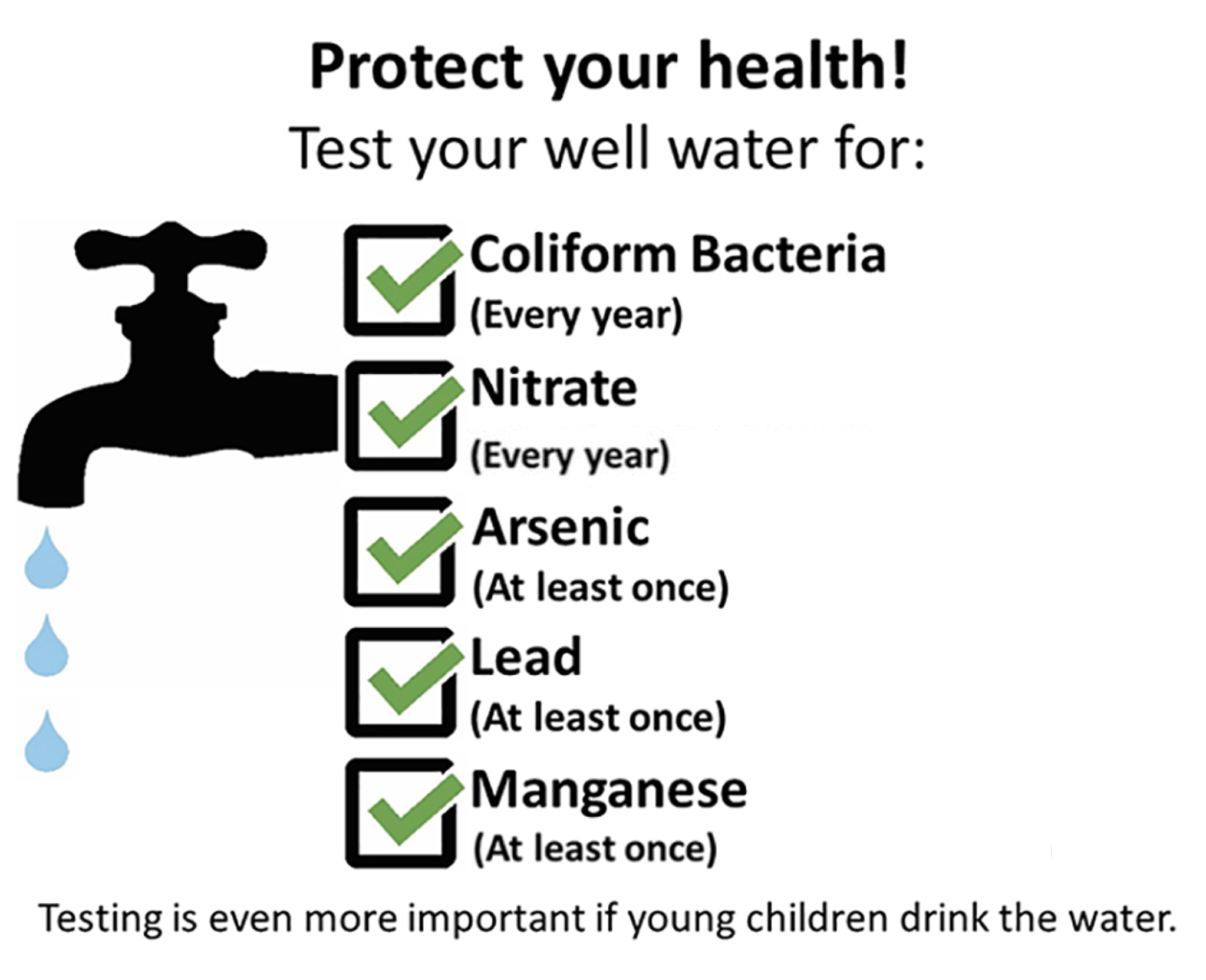Wells and Borings
- Request/Look-up Services
- Wells and Borings Home
- EPA Request: Nitrate
- CEUs
- Construction of Wells and Borings
- Contractors
- Fees
- Laws and Rules
- Licensing
- Minnesota Well Index
- Natural Disasters
- Permits
- Publications
- Resources
- Sealing of Wells and Borings
- Special Construction Areas
- Water Quality and Testing
- Water Information
- Well Disclosure
- Well Partners
Wells Program
Related Topics
- Accredited Laboratories/Well Water Testing
- Clean Water Fund
- Contaminants in Water
- Flooded Wells
- Pesticides
- Water and Health
Environmental Health Division
Lead in Well Water Systems
Lead is a poisonous metal that can cause long-term health and behavioral problems. The main way to come in contact with lead in Minnesota is through lead-based paint in homes built before 1978. There are also many other ways to come in contact with lead, including through drinking water.
Lead in Well Water Systems brochure by language:
English (PDF) | Hmong (PDF) | Somali (PDF) | Spanish (PDF)
There is no safe level of lead
Exposure to lead can cause serious health problems for everyone. There is no safe level of lead. Minnesota Department of Health (MDH) recommends lead levels in water be as close to zero as possible.
Coming in contact with too much lead can damage the brain, kidneys, and nervous system. In children, lead can also slow development or cause learning, behavior, and hearing problems.
Babies, children, and pregnant women are at highest risk

Babies, children under six years old, and pregnant women are at the highest risk of being affected by lead.
- Babies drink more water for their size than older children and adults.
- Babies’ and children’s developing brains and organs can be injured or damaged more easily and their bodies are not very good at getting rid of harmful substances.
- Some contaminants, such as lead, can pass from mother to baby during pregnancy.
For more information see Safe Drinking Water for Your Baby.
Test for lead at least once
You are responsible for keeping your well water safe and testing it as needed. MDH recommends you use an accredited laboratory to test your water. Contact an accredited laboratory to get sample containers and instructions, or ask your county environmental or public health services if they provide well testing services.
Accredited Labs in Minnesota Accepting Samples from Private Well Owners (PDF)
For more information see Well Testing, Results, and Options.

MDH may recommend you test for additional contaminants based on where you live.
How lead gets into well water systems
Groundwater in Minnesota usually does not contain detectable levels of lead. However, the pipes and other components in the household well water system and plumbing may contain lead. If they do, lead may dissolve into the water. The longer the water stands idle in the plumbing pipes and components, the more lead can dissolve into the water.
Sources of lead in well water systems
- Lead pipes are typically the worst contributor to elevated lead levels.
- Lead solder was used in the past to join copper pipes, but has been illegal in Minnesota since 1985.
- Brass components such as faucets, coolers, and valves. Although brass usually contains low lead levels of 8 percent or less, it can still dissolve lead into the water, especially during the first few months of use. If you have new brass plumbing components installed in your plumbing system, be sure to flush the water before drinking. The federal Reduction of Lead in Drinking Water Act requires that most pipe, pipe and plumbing fittings, and fixtures installed in potable water-supply systems after January 2014 must contain no more than 0.25 percent lead.
- Lead "packers" above the well screen were commonly used in wells drilled before 1980. Lead “packers” were sometimes used in wells drilled until 1993 (when they were prohibited).
- Some submersible pumps manufactured before 1995 may contain leaded-brass components. Since January 1995, all submersible pump manufacturers in America have agreed not to use leaded-brass components in submersible pumps.
How to protect your household
Visit Common Sources of Lead to learn about how to reduce your contact with lead from sources other than your drinking water. Use the steps below to reduce your household’s exposure to lead in drinking water.
- Let the water run for at least one minute before using it for drinking or cooking. The more time water has been sitting in your home’s pipes, the more lead it may contain. The only way to know if lead has been reduced by letting it run is to check with a test.
- Use cold water for drinking, making food, and making baby formula. Hot water releases more lead from pipes than cold water.
- Test your water. In most cases, letting the water run and using cold water for drinking and cooking should keep lead levels low in your drinking water. If you are still concerned about lead, arrange with a laboratory to test your water (Accredited Labs in Minnesota Accepting Samples from Private Well Owners [PDF]). Be sure to follow the laboratory’s instructions for collecting the sample.
- First draw sample shows how much lead is in your water after the water sits in your plumbing system for at least 6 hours.
- Flushed samples show how much lead is in your water after letting the water run for a minute or two.
- Treat your water if a test shows your water has high levels of lead after you let the water run. Treatment options include:
- Carbon filters certified to remove lead.
- Reverse osmosis.
- Distillation.
Learn more about these treatment options at the Home Water Treatment webpage.
Should I test my well water for anything besides lead?
Yes. Both natural sources and human activities can contaminate well water and cause short-term or long-term health effects. Testing your well water is the only way to detect most of the common contaminants in Minnesota groundwater; you cannot taste, see, or smell most contaminants. Minnesota Department of Health recommends testing for:
- Coliform bacteria every year and any time the water changes in taste, odor, or appearance. Coliform bacteria can indicate that disease-causing microorganisms may be in your water.
See Bacterial Safety of Well Water. - Nitrate every other year. Bottle-fed infants under six months old are at the highest risk of being affected by levels of nitrate higher than 10 milligrams per liter in drinking water.
See Nitrate in Well Water. - Arsenic at least once. About 40 percent of wells in Minnesota have arsenic in the water. Drinking water with arsenic in it for a long time can contribute to reduced intelligence in children and increased risks of cancer, diabetes, heart disease, and skin problems.
See Arsenic in Well Water. - Manganese before a baby drinks the water. High levels of manganese can cause problems with memory, attention, and motor skills. It can also cause learning and behavior problems in infants and children.
See Manganese in Drinking Water.
Other substances sometimes occur in private water systems, but less often than the contaminants listed above. Consider testing for:
- Volatile organic chemicals if the well is near fuel tanks or a commercial or industrial area.
- Agricultural chemicals commonly used in the area if the well is shallow and is near cropped fields or handling areas for agricultural chemicals or is in an area of geologic sensitivity (such as fractured limestone).
- Fluoride: The right amount of fluoride helps prevent tooth decay. Your baby’s doctor or dentist can help make sure your baby gets the right amount. The ideal level of fluoride in drinking water is 0.7 mg/L or 0.7 ppm to protect teeth.
Questions
Well Management Section
651-201-4600 or 800-383-9808
health.wells@state.mn.us
Go to > top